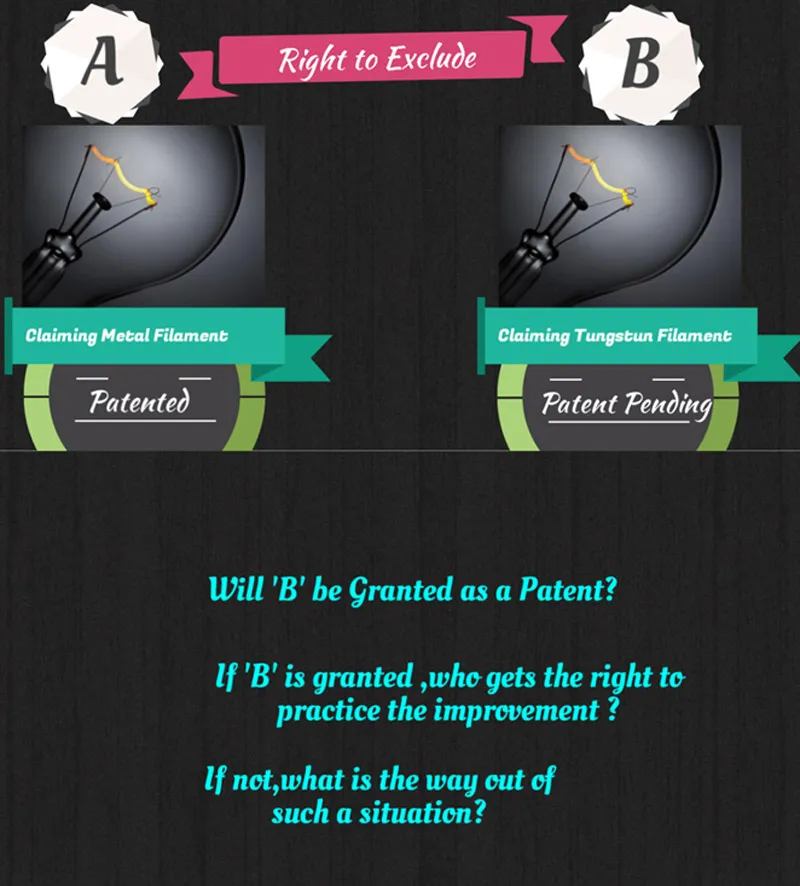Patents are negative rights. Negative? Yes, Patents do not provide monopoly to make, sell or practice the invented technology. They provide a right to exclude others from making, selling, using or importing the patented invention. Doesn’t excluding others mean it is a right to practice absolutely? We are trying to break this myth through an age old example.
The bulb and filament patent scenario

As the info graphic depicts,“A” was granted a patent for an electric lamp/bulb with a metal filament which works as a light omitting object when electricity is passed through the filament. In other words, the patentee had the right to exclude others from making, selling, using or importing an electrical bulb which contains any metal filament.
Some years later, “B” filed another patent application for use of a tungsten filament in electric lamp/bulb. It was well identified by the applicant in the application that use of tungsten improves life and efficiency of the bulb.
The question arises: Can “B” be granted a patent for use of tungsten in the bulb as filament?
To answer this question, at least two pronged tests should be passed by the new application by “B”:
- Novelty: Is use of tungsten “new” with respect to use of metal? Yes, “A” never disclosed use of tungsten, when use of metal is being disclosed. So, disclosure of tungsten is new as it is a specific selection of the metal which was not known before.
B: Obviousness: Is use of tungsten obvious with respect to use of metal? Selecting a specific metal from a large group of metal requires due experimentation which cannot be easily identified by a person who was working in the Bulb manufacturing industry. Such selection of metal requires lot of efforts and cannot be obvious.
As “use of tungsten” as bulb filament passed the two pronged tests, hence it was granted a patent.
Now another question arises: Whether “A” or “B”, who can sell the improvement, i.e., the bulb with tungsten filament?
- Can “A” sell the improvement? No, “A” cannot, as “B” has the right to exclude “A” from selling the tungsten filament bulb.
- Can “B” sell the improvement? No, “B” cannot, as “A” has right to exclude “B” to use of any metal filament bulb, and tungsten is a metal filament.
Oh My God! That means neither “A” nor “B” can practice the improvement. They are at a deadlock. Does that mean, the Patents are ineffective and of no use to society? Not at all, as the patents are granted to protect an inventor/inventors right. However, “A” and “B” have to sit across a table and resolve the deadlock.
There are several patented technologies like the one in the example which belongs to different parties, however these patented technologies are interlinked to manufacture a product or implement a service. Use of such patented technologies result in a deadlock. The deadlock resolution is possible through a Cross Licensing Agreement. Like in this case, a cross licensing agreement has to be drawn between “A” and “B”, where
- “A” can license the right to practice “metal as bulb filament” to “B”
- “B” can license the right to practice “tungsten as bulb filament to “A”
In most cases, these agreements arise when more than one party owns different essential aspects of a commercial product. Many companies involve themselves in such agreements to avoid infringement law suit, or to avoid the risk of re-inventing something that other companies or entities have already patented. This agreement allows the companies to share each other’s resources and share technologies that may improve the industry as a whole.
In a typical licensing scenario, the licensee pays royalties to the licensor using suitable financial models. This may include a yearly royalty, a royalty based on the volume of production, royalty based on volume of sales, etc. But in the case of cross-licensing, most agreements are done on non-royalty basis. Because there is an exchange of valuable assets, there is a mutual understand regarding the financials. This also depends on the strength of the two or more party’s patent portfolio’s, because there may be scenarios where some form of royalty agreements may be made due to the difference in value of one party’s patents over the other.
Hence, patents that have interlinked inventions do have a strong life line. Even though certain patent rights may restrict others from practicing the invented technology, the solution of cross licensing agreements, will benefit both the parties. This also helps in the further development of technologies in those specific domains. Also, through the age old example of the bulb and filament patent scenario, it can be understood that if an invention passes the test of novelty and non-obviousness, a patent may be granted for an improvement of an existing invention as well.
About the authors:
Gaurav Singhal is the Director and Principal IP Attorney at Patracode Services Pvt Ltd. He is a B. Tech in Computer Science, LLB from IIT-Kharagpur and Masters in Business Laws from National Laws School of India University, Bangalore. Gaurav has been working in the IPR field since many years and has been the Strategic IP Counsel at Siemens India, headed Intellectual Property Department of a Singaporean firm, and is also a practicing Patent Agent at the Indian Patent Office. This post has been co-authored with Ananya Dhuddu who works as an Intellectual Property Analyst at Patracode.







